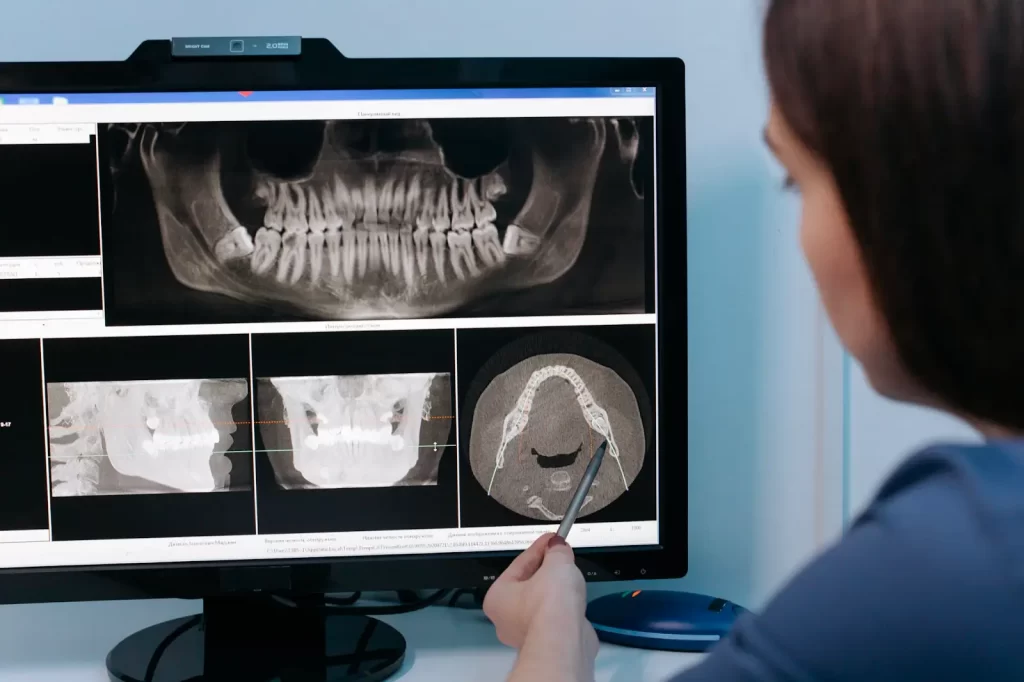Digital Radiography
X-rays have long been a cornerstone in diagnosing a wide range of medical conditions, allowing healthcare professionals to peer inside the body non-invasively. Among the latest advancements in this field, digital X-rays are rapidly transforming the landscape of diagnostic imaging. Much like how digital cameras have replaced film cameras, digital X-rays enhance imaging by allowing immediate image acquisition, modification, and sharing. Digital systems offer significant advantages, including improved image sensitivity, quicker production times, and the benefits of electronic storage. Offering enhanced accuracy and efficiency, digital X-rays are quickly becoming the preferred choice for both dentists and patients, streamlining the diagnostic process while minimizing exposure to radiation.
In this comprehensive guide, we’ll explain the basics of digital x-rays to help patients prepare for treatment and feel more at ease going into their procedures. To schedule an appointment with our Northridge dentist, contact us today by calling 818-709-8645. We also proudly serve patients coming from Granada Hills, Chatsworth, and North Hills.
 What Are Digital X-Rays?
What Are Digital X-Rays?
Dental X-rays provide digital images of a patient’s teeth and surrounding tissues taken using a special form of radiation called ionizing radiation. Digital X-rays are a type of X-ray that is taken on a digital X-ray machine. Digital X-rays are more accurate than traditional X-rays, and they’re better for the environment since they don’t use film or chemicals. Digital X-rays eliminate the need for traditional film development methods, avoiding the errors and degradation associated with chemical processing. This technology captures high-quality digital radiographic images instantly, enhancing diagnostic capabilities and providing rapid access to clear and detailed images for both clinicians and patients.
Digital X-ray machines require less exposure time than traditional X-ray machines because the screen that displays the image is in front of you instead of behind you (like an old film camera). This means you can have your full attention on the patient during their procedure! Digital X-rays also use less radiation than their counterparts, making them safer for everyone involved (including patients who have had prior radiation treatments). They can also be read immediately after being taken by any doctor or technician using only their eyes—no special equipment is needed!
What Is Digital Radiography? Our Dentist Near Granada Hills Explains
Digital radiography (DR) is a cutting-edge form of x-ray imaging that utilizes digital sensors instead of traditional film to capture and store images. This innovative technology has significantly advanced the field of radiology, offering numerous advantages over conventional film-based systems. One of the primary benefits of digital radiography is the production of high-quality digital images that can be easily stored, retrieved, and shared. This capability makes digital radiography an indispensable tool in modern medical imaging, enhancing the efficiency and accuracy of diagnostic processes. With digital radiography, healthcare professionals can quickly access and analyze images, leading to faster and more precise diagnoses.
Why Do You Need Digital X-Rays?
Digital X-rays are a vital tool in modern dentistry, enhancing diagnosis and treatment by providing high-resolution digital images of your teeth. These advanced X-rays help dentists detect cavities, signs of periodontal disease, and other dental issues with greater accuracy, allowing for more effective treatment planning. They are also essential for procedures such as dental restorations, including fillings and crowns, as well as orthodontic treatments like braces.
One of the key benefits of digital X-rays is their efficiency. They require less radiation exposure than traditional film X-rays, making them safer for patients. Additionally, the digital images are processed quickly, enabling dentists to assess your dental health promptly and offer timely care. Digital X-rays are easy to store and access, ensuring that your dental records are readily available when needed. Overall, digital X-rays provide a clearer view of your oral health, helping to ensure you receive the best possible care.
What’s the Difference Between Digital Imaging and Traditional X-Rays?
Traditional film X-rays utilize ionizing radiation to capture an X-ray image of your teeth and jaw by directing a small amount of radiation towards the area being examined, with a special film placed behind it. The radiation passes through the teeth and surrounding tissues, exposing the film, which is then developed through a chemical process to produce a black-and-white image that reveals internal structures of the mouth, helping dentists diagnose issues such as cavities, infections, and bone loss.
However, this method has limitations, including a longer exposure time and environmental concerns due to the chemicals involved in film development. While traditional X-rays can still be useful in certain situations, many dental practices are transitioning to digital radiology for its advantages, such as reduced radiation exposure, faster image acquisition, and enhanced diagnostic capabilities. Digital radiology represents a significant advancement in medical imaging, moving from traditional radiographic films to digital formats, which also improves workflow and reduces the need for chemical processing.
On the other hand, a digital X-ray uses a computer to capture an image of your teeth. This digital information is then sent to the dentist’s office via email or CD, so they can view it on their computer screen. This eliminates the need for film processing and allows for immediate access to treatment options. Digital x-ray units play a crucial role in providing instant image acquisition and sharing, although they may require a higher initial investment and present some challenges during the transition from traditional systems.
Digital X-rays are an important tool in the dental office. They can help detect cavities, and signs of periodontal disease, and even allow for advanced endodontic treatments. Dental X-rays are images of a patient’s teeth and surrounding tissues taken using a special form of radiation called ionizing radiation.
Digital Radiography vs. Computed Radiography
While both digital radiography (DR) and computed radiography (CR) are digital imaging technologies used in radiology, they differ in their methods of capturing and processing images. Digital radiography employs a digital sensor to directly capture the x-ray image, resulting in superior image quality, faster processing times, and reduced radiation exposure. In contrast, computed radiography uses a phosphor plate to capture the image, which is then scanned and digitized. Although CR represents an improvement over traditional film, DR’s direct capture method offers significant advantages, making it the preferred choice for many medical and dental practices. The enhanced image quality and efficiency of DR contribute to more accurate diagnoses and improved patient care.
How Digital X-Rays Work
Digital x-rays utilize advanced technology to capture and process images efficiently. The process involves several key steps:
- X-ray Production: An x-ray machine generates a beam of x-rays that passes through the body.
- Image Capture: A digital sensor captures the x-ray image, converting it into an electrical signal.
- Image Processing: The electrical signal is processed and enhanced to produce a high-quality digital image.
- Image Storage: The digital image is stored on a computer or server, making it easily accessible for retrieval and analysis.
This streamlined process allows for immediate viewing and assessment of the x-ray image, facilitating prompt and accurate diagnosis. The use of digital sensors and advanced processing techniques ensures that the resulting images are clear and detailed, providing valuable insights into the patient’s condition.
What Exactly Are Digital X-Rays Used For?
Digital X-rays are essential tools in modern dentistry and medicine, used to diagnose a variety of diseases and injuries. Digital radiography systems utilize advanced technology to capture and convert images to digital format in real-time, enhancing workflow and image quality. They are particularly effective in detecting dental problems, including cavities, gum disease, and infections. By providing high-resolution images, a digital X-ray allows our Northridge dentist to identify early signs of tooth decay and assess the severity of existing issues, such as cracks or fractures in teeth that may not be visible during a routine examination.
Additionally, they can reveal underlying conditions like bone loss due to periodontal disease, which is crucial for determining the appropriate treatment plan. The clarity and detail offered by digital X-rays enable us to address dental issues more accurately and efficiently, ensuring you receive the best care possible. If you have any questions about digital X-rays or would like more information about their benefits and procedures, please feel free to call our Northridge dental office at 818-709-8645 today!
Digital Images and Storage
One of the significant advantages of digital radiography is the ability to store images electronically. Digital radiography images can be stored on various media, including hard drives, CDs, and cloud storage, ensuring they are easily retrievable and shareable. The use of digital imaging and communication in medicine (DICOM) standards ensures compatibility and security when storing and transmitting medical images. This standardization allows healthcare professionals to share digital images seamlessly, eliminating the need for physical film and reducing the risk of lost or damaged images. The ease of storage and sharing enhances the efficiency of medical record-keeping and improves collaboration among healthcare providers, ultimately benefiting patient care.

Frequently Asked Questions
What are the main benefits of digital X-rays compared to traditional film X-rays?
Digital X-rays provide several advantages over traditional film X-rays, including higher image quality and detail, faster processing times, and lower radiation exposure. They allow dentists to quickly assess dental issues and make informed treatment decisions. Additionally, digital X-rays are easily stored and shared, enhancing patient records management.
How much radiation exposure is involved in a digital X-ray, and is it safe?
Digital X-rays use significantly less radiation than traditional film X-rays, making them safer for patients. The amount of radiation exposure is minimal and comparable to that of a single day of natural background radiation. Dentists take precautions to ensure patient safety, including using lead aprons when necessary.
How quickly can my dentist review the results of a digital X-ray?
One of the key benefits of digital X-rays is the speed at which results can be reviewed. Dentists can view the images almost instantly on a computer screen, allowing for immediate assessment and faster treatment planning. This quick turnaround enhances the overall efficiency of dental care.
Are digital X-rays suitable for all dental patients, including children?
Yes, digital X-rays are suitable for most dental patients, including children. They are particularly beneficial for young patients due to the lower radiation exposure. However, your dentist will assess each individual’s needs and may recommend X-rays based on their specific dental situation and health history.
Transform Your Dental Care with Digital X-Ray Technology at Dr. Gropp’s Office
Digital X-rays at the Northridge dental office of Dr. Kevin H. Gropp are a valuable tool for diagnosing and treating dental issues effectively. These advanced imaging techniques provide high-quality, detailed images of your teeth and surrounding structures, allowing for accurate assessments and treatment planning. Dr. Gropp’s expertise and our dedication to personalized service guarantee that you’ll receive the best possible dental care for a healthy, confident smile, don’t wait any longer.
Schedule a consultation with our Northridge dentist today by calling 818-709-8645. We’re happy to accept new and returning patients from the San Fernando Valley, Northridge, and the surrounding Los Angeles areas, such as Granada Hills, Reseda, and Lake Balboa, CA.

